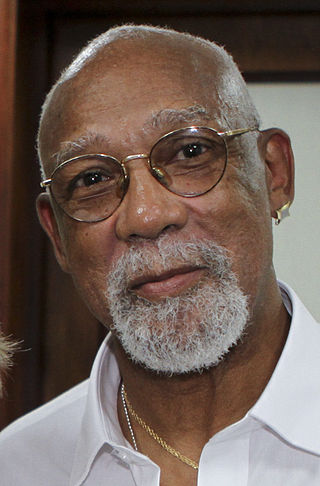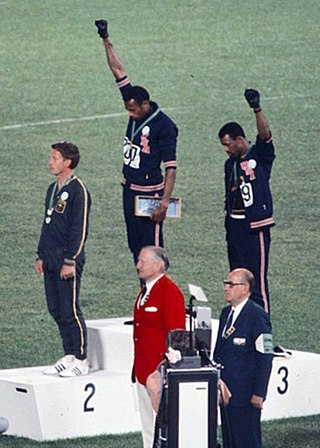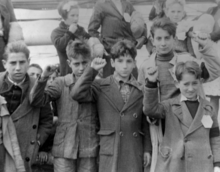
A salute is usually a formal hand gesture or other action used to display respect in military situations. Salutes are primarily associated with the military and law enforcement, but many civilian organizations, such as Girl Guides, Boy Scouts and the Salvation Army use formal salutes. Ordinary civilians also salute informally to greet or acknowledge the presence of another person, such as a tip of the hat or a hand wave to a friend or neighbor.
The 1968 Summer Olympics, officially known as the Games of the XIX Olympiad and commonly known as Mexico 1968, were an international multi-sport event held from 12 to 27 October 1968 in Mexico City, Mexico. These were the first Olympic Games to be staged in Latin America and the first to be staged in a Spanish-speaking country. They were also the first Games to use an all-weather (smooth) track for track and field events instead of the traditional cinder track, as well as the first example of the Olympics exclusively using electronic timekeeping equipment.

The Roman salute, alternatively called the Fascist salute, is a gesture in which the right arm is fully extended, facing forward, with palm down and fingers touching. In some versions, the arm is raised upward at an angle; in others, it is held out parallel to the ground. In contemporary times, the former is commonly considered a symbol of fascism that had been based on a custom popularly attributed to ancient Rome. However, no Roman text gives this description, and the Roman works of art that display salutational gestures bear little resemblance to the modern Roman salute.

In politics, a red flag is predominantly a symbol of left-wing politics, including socialism, communism, Marxism, labour movement, and anarchism. The originally empty or plain red flag has been associated with left-wing politics since the French Revolution (1789–1799).

Tommie C. Smith is an American former track and field athlete and former wide receiver in the American Football League. At the 1968 Summer Olympics, Smith, aged 24, won the 200-meter sprint finals and gold medal in 19.83 seconds – the first time the 20-second barrier was broken officially. His Black Power salute with John Carlos atop the medal podium to protest racism and injustice against African Americans in the United States caused controversy, as it was seen as politicizing the Olympic Games. It remains a symbolic moment in the history of the Black Power movement.

John Wesley Carlos is an American former track and field athlete and professional American football player. He was the bronze-medal winner in the 200 meters at the 1968 Summer Olympics, where he displayed the Black Power salute on the podium with Tommie Smith. He went on to tie the world record in the 100-yard dash and beat the 200 meters world record. After his track career, he enjoyed a brief stint in the Canadian Football League but retired due to injury.
Fascist symbolism is the use of certain images and symbols which are designed to represent aspects of fascism. These include national symbols of historical importance, goals, and political policies. The best-known are the fasces, which was the original symbol of fascism, and the swastika of Nazism.

The protests of 1968 comprised a worldwide escalation of social conflicts, which were predominantly characterized by the rise of left-wing politics, anti-war sentiment, civil rights urgency, youth counterculture within the silent and baby boomer generations, and popular rebellions against state militaries and bureaucracies.

During their medal ceremony in the Olympic Stadium in Mexico City on October 16, 1968, two African-American athletes, Tommie Smith and John Carlos, each raised a black-gloved fist during the playing of the US national anthem, "The Star-Spangled Banner". While on the podium, Smith and Carlos, who had won gold and bronze medals respectively in the 200-meter running event of the 1968 Summer Olympics, turned to face the US flag and then kept their hands raised until the anthem had finished. In addition, Smith, Carlos, and Australian silver medalist Peter Norman all wore human-rights badges on their jackets.

The Olympic Project for Human Rights (OPHR) was an American organization established by sociologist Harry Edwards and multiple Black American athletes, including noted Olympic sprinters Tommie Smith and John Carlos, on October 7, 1967. The purpose of the group was to advocate for civil rights and human rights for Black people in the United States and abroad, along with protesting racism in sport in general. The OPHR proposed a complete Black athlete boycott of the 1968 Summer Olympics in Mexico City to achieve its goals. While the OPHR advocated for a boycott backed by all Black Americans, the group did not actively include women in its discussions and in the end was mostly composed of track and field athletes.

Salute is a 2008 Australian sports documentary film directed, produced and written by Matt Norman. It tells the role of Peter Norman, Norman's uncle, in a defining moment of the American civil rights movement: the 1968 Olympics Black Power salute.
Frank Cieciorka was an American graphic artist, painter, and activist. His best known work, a woodcut rendering of a clenched-fist salute, was a model for the New Left emblem.

The Nazi salute, also known as the Hitler salute, or the Sieg Heil salute, is a gesture that was used as a greeting in Nazi Germany. The salute is performed by extending the right arm from the shoulder into the air with a straightened hand. Usually, the person offering the salute would say "Heil Hitler!", "Heil, mein Führer!", or "Sieg Heil!". It was officially adopted by the Nazi Party in 1926, although it had been used within the party as early as 1921, to signal obedience to the party's leader, Adolf Hitler, and to glorify the German nation. The salute was mandatory for civilians but mostly optional for military personnel, who retained a traditional military salute until the failed assassination attempt on Hitler on 20 July 1944.
The Reaper, also known as Catalan peasant in revolt was a large mural created by Joan Miró in Paris in 1937 for the Spanish Republic’s pavilion at the 1937 Paris International Exhibition. One of Miró's largest works, it was destroyed or lost in 1938, and only a few black and white photographs survive.
Communist symbolism represents a variety of themes, including revolution, the proletariat, the peasantry, agriculture, or international solidarity. The red flag, the hammer and sickle and the red star or variations thereof are some of the symbols adopted by communist movements, governments, and parties worldwide.

The Three Arrows is a social democratic political symbol associated with the Social Democratic Party of Germany (SPD), used in the late history of the Weimar Republic. First conceived for the SPD-dominated Iron Front as a symbol of the social democratic resistance against Nazism in 1932, it became an official symbol of the Party during the November 1932 German federal election, representing their opposition towards monarchism, Nazism, and communism.

The three-finger salute is a hand gesture made by raising the index, middle and ring fingers, while holding the thumb to the little finger, and raising the hand with the palm facing out in a salute. The gesture was popularized in the 2010s after its use in The Hunger Games as a symbol of revolution. The gesture has been adopted by protesters, particularly for pro-democracy protest movements in Southeast Asia, mainly in Thailand and Myanmar, as well as in other countries, including Hong Kong.

The fist and rose, sometimes called the rose in the fist or fist with a rose, is an emblem used or formerly used by a number of socialist and social democratic parties around the world.































